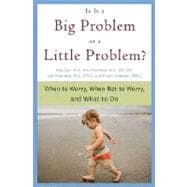
Note: Supplemental materials are not guaranteed with Rental or Used book purchases.
Purchase Benefits
Looking to rent a book? Rent Is It a Big Problem or a Little Problem? When to Worry, When Not to Worry, and What to Do [ISBN: 9780312354121] for the semester, quarter, and short term or search our site for other textbooks by Egan, Amy; Freedman, Amy; Greenberg, Judi; Anderson, Sharon. Renting a textbook can save you up to 90% from the cost of buying.
| Acknowledgments | p. xi |
| The Basics | |
| Prologue: Starting on the Right Foot | p. 3 |
| A Child in His Environment | p. 13 |
| Play | p. 28 |
| Understanding Development | |
| Social Emotional Development and Managing Behavior | p. 45 |
| Speech and Language Development | p. 75 |
| Motor Development | p. 106 |
| Sensory Processing | p. 131 |
| Where Children Struggle | |
| Life at Home | p. 165 |
| Life Away from Home | p. 201 |
| Siblings and Playmates | p. 215 |
| Parks and Playgrounds | p. 224 |
| Holidays, Celebrations, and Birthday Parties | p. 232 |
| Out and About | p. 247 |
| Epilogue: Falling Down, Reaching for the Stars, and Coping with Feelings | p. 267 |
| Appendices | |
| Quick Reference Guide of Tips and Strategies | p. 273 |
| Early Warning Signs of Big Problems | p. 275 |
| Is My Child Ready for Preschool? | p. 277 |
| Is My Child Ready for Kindergarten? | p. 281 |
| Using Visuals to Support Children and Enhance Learning | p. 284 |
| How to Make and Use Behavior Plans and Star Charts | p. 291 |
| Working with Other Professionals | p. 297 |
| Resource Guide | p. 303 |
| End Notes | p. 313 |
| Bibliography | p. 317 |
| Selected Reading | p. 323 |
| Index | p. 325 |
| Table of Contents provided by Ingram. All Rights Reserved. |
The New copy of this book will include any supplemental materials advertised. Please check the title of the book to determine if it should include any access cards, study guides, lab manuals, CDs, etc.
The Used, Rental and eBook copies of this book are not guaranteed to include any supplemental materials. Typically, only the book itself is included. This is true even if the title states it includes any access cards, study guides, lab manuals, CDs, etc.
Excerpted from Is It a Big Problem or a Little Problem?: When to Worry, When Not to Worry, and What to Do by Amy Egan, Amy Freedman, Judi Greenberg, Sharon Anderson
All rights reserved by the original copyright owners. Excerpts are provided for display purposes only and may not be reproduced, reprinted or distributed without the written permission of the publisher.